Introduction
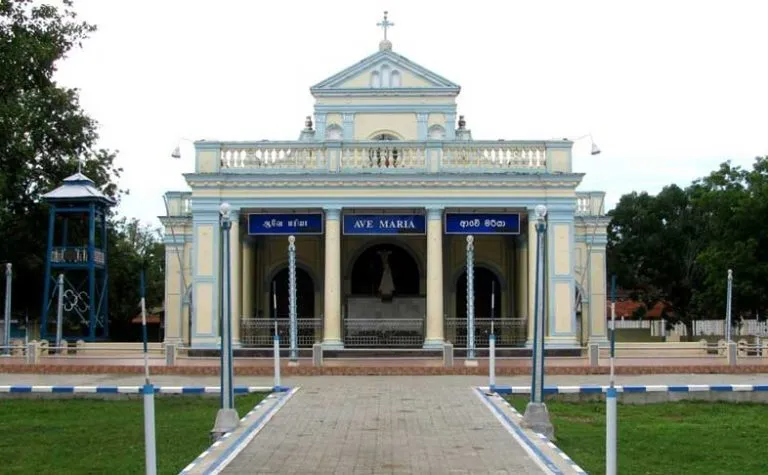
The Shrine of Our Lady of Madhu or Our Lady Of The Rosary of Madhu is a Roman Catholic Marian shrine in Mannar district of Sri Lanka. With a history of over 400 years, this shrine acts as a center for pilgrimage and worship for Sri Lankan Catholics. The site is considered as the holiest Catholic shrine in the island and is a well known place of devotion for both Tamil and Sinhalese Catholics. The church has been a symbol of unity not just between Tamils and Sinhalese, but also between people of different religions, including Buddhists, Hindus and Protestants.
Pope Pius XI granted the image of Our Lady of Madhu a Canonical coronation on 2 July 1924. Attendance for the August festival at times touched close to a million people before the outbreak of the Sri Lankan Civil War. Situated in the heart of the conflict zone, pilgrimage to this shrine was dramatically affected by the Civil War with the presence of refugee camps around the shrine complex. It was shelled a number of times. Using our custom trip planner, Mannar attractions like Shrine of Our Lady of Madhu can form part of a personalized travel itinerary.
Long considered to be the holiest place of Roman Catholic worship in Sri Lanka, the Shrine of Our Lady of Rosary in Madhu is a beacon of hope and faith. Situated in Mannar, one can reach the holy premises via the secluded road stretching through the Madhu Sanctuary. Blue flags flutter high in the wind and adorn the church precincts, almost blending with the skyline. The solemn structure in blue and white comes into sight, upon entering the sacred grounds.
In 2015, his Holiness Pope Francis set foot on this hallowed soil which is revered by many as the dwelling place of divine presence. Pope Francis also opened the Blessed Sacrament Chapel during his holiness’s visit.
The Shrine of Our Lady of Madhu is a profound religious site of great spirituality and divinity.
The move was ostensibly to protect the image from the colonial Dutch, who had closed churches and banned priests. Saint Joseph Vaz, an Oratorian priest from Goa, also came to the area during this period and took refuge at Madhu.
The shrine had been established for almost two centuries, when a large church was built in 1872, along with a grotto and presbytery for priests. Madhu Shrine received papal recognition when Pius XI gave permission for a solemn canonical “coronation” of Our Lady of Madhu, which was accomplished in 1924, with the church being formally consecrated in 1944.
During the Sri Lankan civil war (1983-2009), Madhu Shrine was a neutral area for refugees. Its status as a safe space, however, did not protect refugees from being shelled in during what came to be known as “The Madhu Church massacre.” Also during this period, a claymore mine was also detonated under a school bus in the area, killing 16 adults and children. Our Lady of Madhu was brought out three times for a “penitential pilgrimage” throughout Sri Lanka to end the war. When the Sri Lankan government moved to exert authority over the area, the statue of Our Lady of Madhu was moved into rebel-held areas for safe keeping before finally being returned.
While July 2 is the official festival day for Our Lady of Madhu, the celebration that draws most crowds is the Feast of the Assumption on August 15. On that date, Our Lady of Madhu is brought out for a formal procession. It is said that during the period of the civil war, Sri Lankans would look closely at Our Lady of Madhu’s Crown during the procession—if it fell, it would mean that fighting would resume. There are a number of other legends associated with Madhu Shrine, particularly surrounding snakes. It is said that when Joseph Vaz came to Madhu, snakes fled the area, only returning when Our Lady of Madhu was taken away from the area for safekeeping during the civil war. When Our Lady of Madhu returned, it is said that the snakes were driven away once again.
Madhu Shrine is located in the Mannar diocese, a Tamil speaking area in the northwest part of Sri Lanka. However, Madhu is sacred to both Tamil and Singhalese Catholics, and even Buddhists and Muslims would also come to the shrine to pay respects to Mother Mary. Madhu Shrine hosts pilgrims throughout the year. Usually, pilgrims come for several days, and stay in one of the hostels especially reserved for them. Signs make it clear that alcohol is prohibited along with dancing and “merry-making” of any kind. Pilgrims usually buy medals, scapulars, and images of Our Lady of Madhu, which they have blessed by a priest.
Madhu Church has a large “Ave Maria” sign, along with its transliterations in Sinhala and Tamil. Inside the church, pilgrims walk on their knees to approach Our Lady of Madhu and present their intentions. Flowers are also offered — which interestingly is also characteristic of worship in Buddhist and Hindu temples. Cut into the floor of Our Lady of Madhu Church is a pit that holds soil from the area in which St. Joseph Vaz said Mass while at Madhu. The soil is reputed to have curative properties, and is especially used as an antidote for snakebite. Madhu soil is mixed in concrete for the foundations of Catholic homes, and the soil is sometimes added to water and consumed by pilgrims. Surrounding Madhu Church is a large Way of the Cross. A panoramic view of the area gives a sense of the space needed to accommodate crowds during festivals.
Our Lady of Madhu is in the middle of the jungle. The Madhu Church Road branches off from highway A14 and is marked by a large gate. Nearby, a hotel (the term for restaurants in Sri Lanka) managed by the Sri Lankan Army sells rice and curry for pilgrims. Another road leads out from Madhu Shrine through an area that has yet to be fully cleared of mines and IEDs. This road emerges at Andankulam junction, where there is a much smaller shrine to the Passion of Jesus Christ.
History of Shrine of Our Lady of Madhu
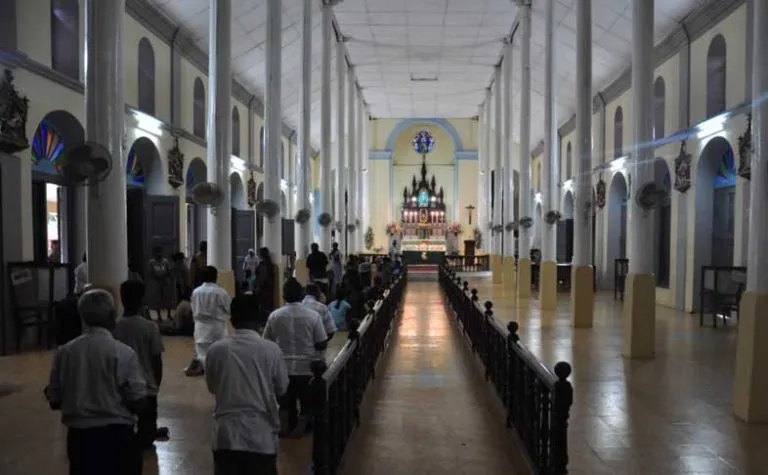
Christianity in Sri Lanka is not well known before the 16th century although some local traditions claim that Saint Thomas the Apostle was active in the island. The Portuguese missionaries from India, especially under the authority of Saint Francis Xavier, are known to have brought Roman Catholicism to the Kingdom of Jaffna, which comprised the northern peninsula of Sri Lanka. The newly converted Christians were persecuted under both the king of Jaffna and the Dutch. During this time the Catholics regrouped to form a church in Manthai, installing a statue of Our Lady of Good Health in a shrine.
The Dutch invasion and the persecution of the Catholic Church in 1670 led to 20 Catholic families fleeing from Mantai, along with the statue of Mary in that church, to the safer locale of Madhu. About the same time another 700 Catholics migrated from Jaffna peninsula into Wanni forests. When these two communities met in Madhu they installed a new shrine with the statue.
Amidst the many legends surrounding the origins of the church the most likely one is that the statue of the Virgin Mary carrying Baby Jesus, arrived in Mannar aboard a ship from either Portugal or Goa. The worship of the Virgin Mary, took root at this spot amongst a small community.
The small church gradually earned repute for possessing the power of healing drawing more devotees to seek refuge. In 1705, it was renovated by Bishop Joseph Vaz who arrived from Goa in disguise to avoid persecution from the Dutch. The church gradually evolved in structure and its famous annual pilgrimage was initiated by the Oblate Bishop Christopher Bonjean, OMI, in 1872. He arrived in 1868, following his missions in India and discovered the small mud church in a state of ruin and extensive renovations were carried out some years later. The magnificent façade, a spacious presbytery, and the chapel of the Blessed Sacrament were added in time.
Every August, the small town of Madhu witnesses the arrival of hundreds of thousands of Roman Catholics from all parts of Sri Lanka to celebrate the annual Feast of the Visitation. Although the church celebrates several festivals throughout the year, the Madhu Festival in August is probably the most important Catholic event, drawing hundreds of thousands of believers from across the country. While the feast in August is indeed exceptional, the faithful arrive throughout the year. Pope Francis I visited Madhu Church during his visit to Sri Lanka in January, 2015.
Architecture
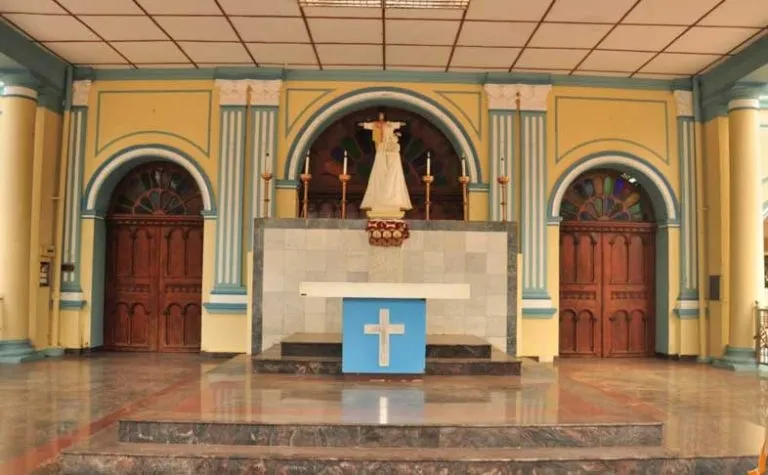
Architectural Style : Baroque Revival architecture.
With the revival of Catholic faith by missionaries such as Saint Joseph Vaz, Oratorian priests expanded the small shrine in the late 17th century. With the arrival of British to the island, the persecution ceased, but the number of Catholics remained small, with just 50,000 members in 1796. In spite of such a small community the shrine at Madhu started to attract pilgrims from all over the country. The stifling of Jesuit authority which had started in 1773 in the subcontinent led eventually to the suppression of the Society of Jesus in Madhu by 1834. The building of the new church was initiated by Bishop Bonjean in 1872 and his successors built a facade, a spacious presbytery, a restful chapel of the Blessed Sacrament and a grotto of Our Lady of Lourdes.
Our Lady of Madhu
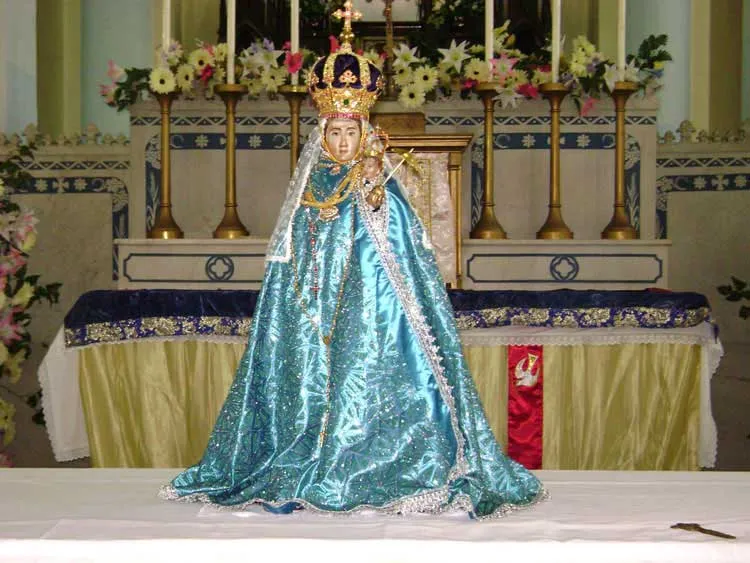
Our Lady of Madhu, the statue was moved from the front lines during the last phase of the civil war is renowned for its protective power not only in times of war, famine, and epidemic, but also in cases of snake bites, purportedly by preventing them. Venerated as the “Queen of Snakes” in a region infested by up to thirty different species of snakes, Our Lady is said to protect pilgrims against the dangers of the snakes’ deadly poison. Tradition attributes a special healing quality and power to the soil of Madhu–still another favor granted through the intercession of Our Lady. As for many other origins of Marian images, it is said that the statue of Our Lady of Madhu was rediscovered in 1670, miraculously hidden in the trunk of a tree.
Maybe one of the most astounding characteristics of this Marian icon is its ecumenical appeal and outreach. Only about 7% of the Sri Lankan population, Sinhalese and Tamil, is Catholic, but the shrine attracts also Buddhist Sinhalese and predominately Hindu Tamils. The celebration of Assumption on August 15, 2009 drew, according to some news sources, up to five hundred thousand pilgrims bringing together Catholics, Buddhists and Hindus, Tamils as well as Sinhalese. This may be the most important miracle yet that we owe to Our Lady of Madhu’s intercession, that this venerated image of Mary can bring together all Sri Lankans.
The Miraculous Statue of Mother Mary
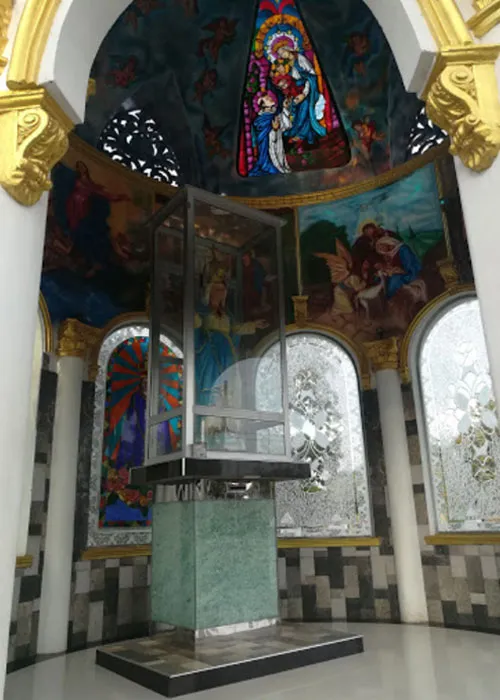
The miraculous statue of Mother Mary holding the infant Jesus at its altar has an intriguing history and much of its past has been lost with time. The initial abode of Our Lady of Madhu is said to have been in Mantai, situated a short distance away from its present place. According to the annals of history, a woman named Helena is said to have been instrumental in building the first shrine in Madhu.
A time-honoured tradition, camping in the church grounds is a ritual of the Madhu pilgrimage. Some set up makeshift tents while others will reside in small houses, which is an alternative to camping. The benevolent statue of Our Lady of Madhu, has for years offered solace, blessings and refuge to the ones who come to experience her divine presence. For its island wide flock, this shrine nested amidst a dense jungle, is the ultimate safe haven. Even after the annual feast concludes, crowds gather in throngs all year round seeking the holy mother’s blessings.
Pontifical Coronation
In 1920, Bishop Brault, who was very devoted to Our Lady of Madhu, obtained the Pope’s sanction for the historic solemn Canonical Coronation of the Statue of Our Lady of Madhu. Bishop Brault with the clergy and laity had petitioned the Holy See through the Cardinal Willem Marinus van Rossum, the Prefect of the Congregation for the Evangelization of Peoples. Cardinal Van Rossum personally presented the request to the Pontiff, who granted in his audience of 7 April 1921. In 1924, the statue was officially crowned by the Papal Legate who came in the name of Pope Pius XI.
Consecration of the Church
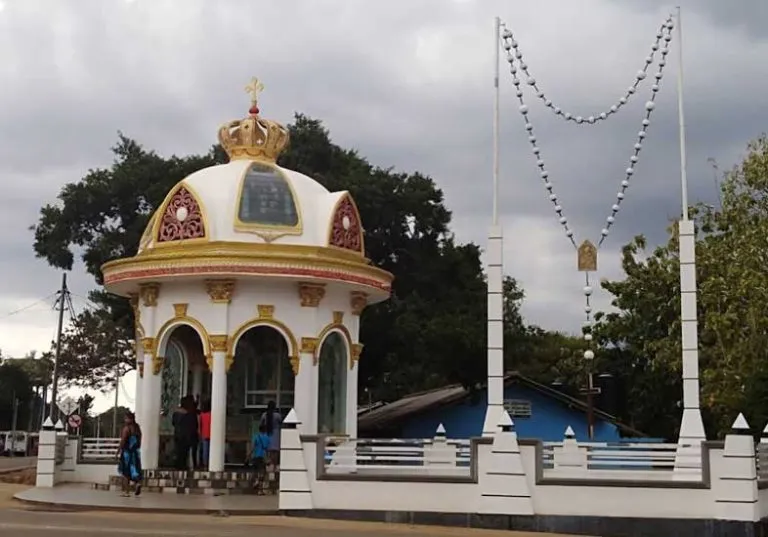
The church was consecrated in 1944 during World War II. In preparation for the consecration ceremony, a marble altar replaced the old wooden structure and the whole sanctuary was covered with white and blue marble. In spite of travel restrictions and difficulties in finding conveyance, more than 30,000 people came to the jungle shrine.
The Penitential Tour
The statue of Our Lady of Madhu has been taken for procession thrice to the parishes in Sri Lanka, in 1948, 1974 and in 2001. The latter was as a spiritual effort to encourage Catholics in Sri Lanka to pray for peace and an end to the civil war.
Feast Day – 15th August
The Feast of Our Lady of Madhu Church, Mannar will take place from August 6 to August 15. The Hoisting of the Flag is on 6th August and Assumption of Mother Mary is on 15th August. Every August the tranquil town of Madhu witnesses the arrival of thousands and thousands of devotees of all faiths, from across the island.
All year long Mother Mary’s life is celebrated here but the grandest celebration of all is held in August, which coincides with the Feast of Mother Mary’s Assumption to heaven. With the flag hoisting starts the nine-day preparatory period before the Feast of Our Lady of Madhu.
A sense of buoyant joy as well as spirituality resonates within the sanctum during the Grand Feast of Madhu. The sacred ground throbs with exuberant devotion as devotees gather for prayers in deep veneration.
In 1870 the new bishop arranged an annual festival to be celebrated on July 2. However, in recent years the August 15th festival has drawn the biggest crowds because it is one of the most hallowed days for Catholics, the feast of the Assumption of the Blessed Virgin Mary into heaven, and it comes during school holidays when entire families can make the trip.
Mass Time
Weekdays
Sundays
Church Visiting Time
Contact Info
Shrine of Our Lady of Madhu,
Puliyadi Irakkamam, Madhu Road,
Mannar – 41000, Sri Lanka
Phone No.
Tel : +94 232 280 001
Accommodations
How to reach the Shrine
Talladi Mini Runway – Mannar District is the nearest airport to the shrine.
Thandikulam Train station, Vavuniya Train station, Irataperiyakulam Sub Railway Station these are the train stations nearby the shrine.
Madhu Road Junction is the bus stop nearby the Shrine.







